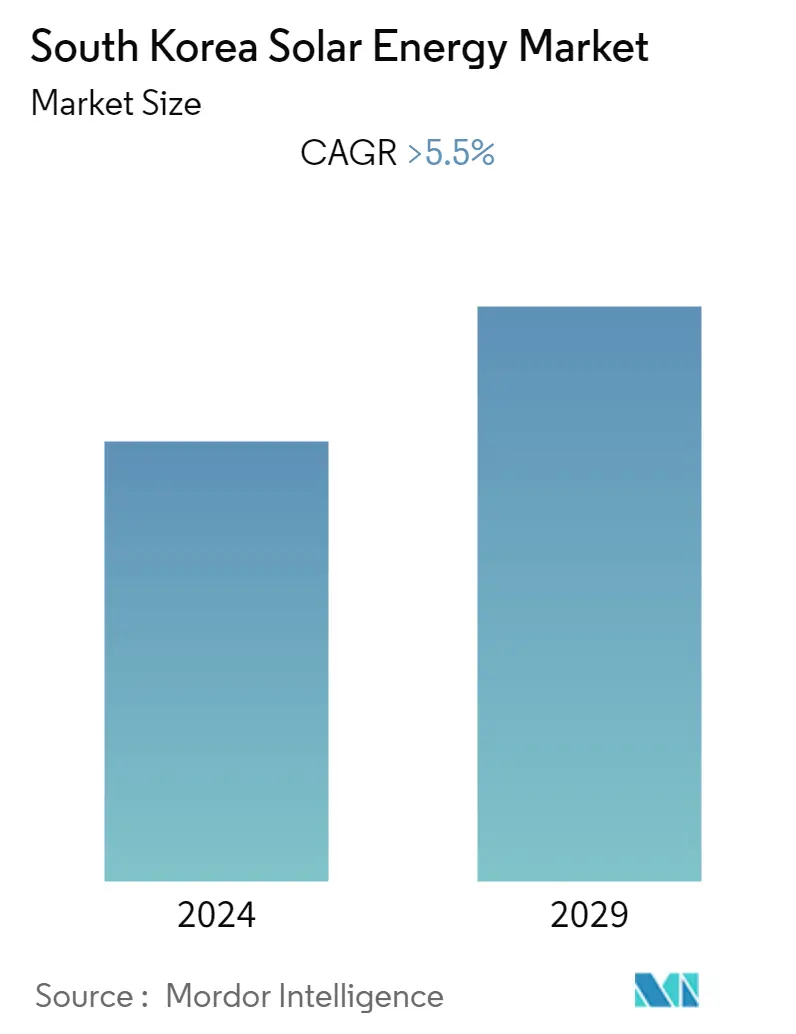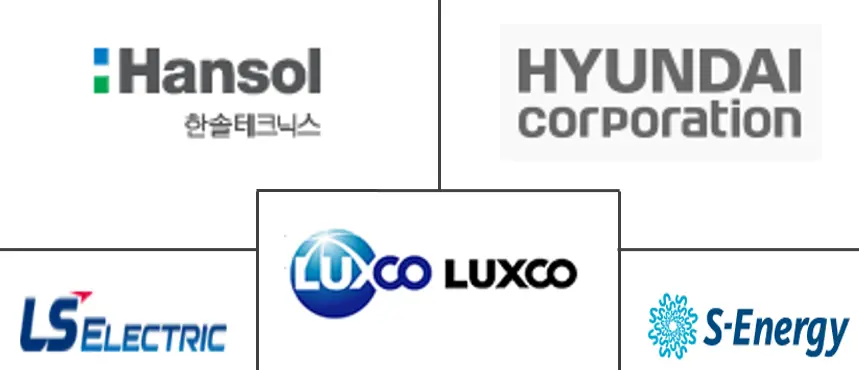Market Size of South Korea Solar Energy Industry

| Study Period | 2020 - 2029 |
| Base Year For Estimation | 2023 |
| Forecast Data Period | 2024 - 2029 |
| Historical Data Period | 2020 - 2022 |
| CAGR | > 5.50 % |
| Market Concentration | Medium |
Major Players
*Disclaimer: Major Players sorted in no particular order |
South Korea Solar Energy Market Analysis
The South Korean solar energy market is expected to witness a CAGR of around 5.5% during the forecast period. The COVID-19 outbreak did not have a significant impact on the South Korean solar energy market. The country witnessed an addition of around 2.6 GW of solar capacity in 2019-2020, without any delays in the projects targeted to be completed during the year. The South Korean solar energy market is expected to witness significant growth in the coming years, as the country gets a lot of sunlight and the government strongly supports the growth of renewables in the energy sector. However, the competition from other cleaner energy sources like natural gas and nuclear energy can impede the market's growth.
- The new upcoming solar photovoltaic (PV) projects planned by the private players in the country are expected to drive the market in the future.
- The country has hinted at phasing out coal-based power generation in the coming years. It plans to eject out 36.4 GW of coal power capacity by 2029, creating a tremendous opportunity for the increased penetration of renewables in the power generation sector.
- The government policies in favor of emission-free energy sources are expected to propel the market in the future.
South Korea Solar Energy Industry Segmentation
The scope of the South Korean renewable energy market report includes:
South Korea Solar Energy Market Size Summary
The South Korean solar energy market is poised for substantial growth, driven by favorable government policies and an abundance of sunlight. The country's commitment to renewable energy is evident in its plans to phase out coal-based power generation, creating opportunities for solar energy expansion. Despite competition from other clean energy sources like natural gas and nuclear power, the market is expected to thrive due to the declining costs of solar technology and significant investments from private sector players. The government's supportive initiatives, including the Carbon Neutrality Bill and the Korea New Deal Fund, further bolster the market's prospects by encouraging the transition to emission-free energy sources.
The solar photovoltaic (PV) sector is a key driver of the market, with numerous projects underway to enhance the country's solar capacity. The South Korean government has been proactive in facilitating solar PV installations through tenders and procurement rounds, aiming to increase the share of renewables in the energy mix. The market is moderately fragmented, with key players such as Hansol Technics Co. Ltd, Hyundai Corporation, and LS Electric Co. Ltd contributing to its development. Notable projects, including the Saemangeum Floating Solar Power Project, highlight the country's commitment to expanding its solar energy infrastructure. As South Korea continues to invest in green technology and infrastructure, the solar energy market is expected to experience robust growth in the coming years.
South Korea Solar Energy Market Size - Table of Contents
-
1. MARKET OVERVIEW
-
1.1 Introduction
-
1.2 Market Size and Demand Forecast in USD billion, till 2027
-
1.3 Recent Trends and Developments
-
1.4 Government Policies and Regulations
-
1.5 Market Dynamics
-
1.5.1 Drivers
-
1.5.2 Restraints
-
-
1.6 Supply Chain Analysis
-
1.7 PESTLE Analysis
-
South Korea Solar Energy Market Size FAQs
What is the current South Korea Solar Energy Market size?
The South Korea Solar Energy Market is projected to register a CAGR of greater than 5.5% during the forecast period (2024-2029)
Who are the key players in South Korea Solar Energy Market?
Hyundai Corporation, Luxco Co. Ltd, Hansol Technics Co. Ltd, S Energy Co. Ltd and LS Electric Co. Ltd are the major companies operating in the South Korea Solar Energy Market.

